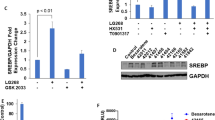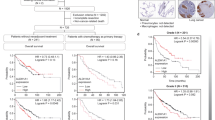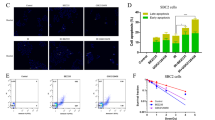Abstract
Human aldo-keto reductase 1C3, type 2 3α-hydroxysteroid dehydrogenase (HSD)/type 5 17β-HSD (AKR1C3) is known to be involved in steroid, prostaglandin and lipid aldehyde metabolism. The role of AKR1C3 in the radiosensitivity to X-rays of human non-small-cell lung cancer (NSCLC) cells was explored. In this study, a specific small interfering RNA (siRNA) to target the AKR1C3 gene was used. A suite of readouts including cell survival were determined using a colony formation assay; apoptosis evaluated by Annexin V expression levels, irradiation-induced cytotoxicity established using a MTT cell viability assay and cell cycle distribution measured by flow cytometry were used in characterizing the role of the AKR1C3 gene. Although AKR1C3 was significantly overexpressed in both our radioresistant subclone cells and NSCLC tissues, a specific AKR1C3 siRNA significantly enhanced cell radiosensitivity and was concomitant with decreased expression of this gene. Furthermore, reduced interleukin-6 (IL-6)-mediated radioresistance was observed when siRNA was used to knock down AKR1C3 activity. This AKR1C3-mediated radioresistance was correlated with an arrest in the G2/M cell cycle and a decreased induction of apoptosis. AKR1C3 may present a potential therapeutic target in addressing radioresistance of NSCLC, and in particular in IL-6-mediated radioresistance.
This is a preview of subscription content, access via your institution
Access options
Subscribe to this journal
Receive 12 print issues and online access
$259.00 per year
only $21.58 per issue
Buy this article
- Purchase on Springer Link
- Instant access to full article PDF
Prices may be subject to local taxes which are calculated during checkout






Similar content being viewed by others
References
Ringborg U, Bergqvist D, Brorsson B, Cavallin-Stahl E, Ceberg J, Einhorn N et al. The Swedish Council on Technology Assessment in Health Care (SBU) systematic overview of radiotherapy for cancer including a prospective survey of radiotherapy practice in Sweden 2001--summary and conclusions. Acta Oncol 2003; 42: 357–365.
Penning TM, Burczynski ME, Jez JM, Hung CF, Lin HK, Ma H et al. Human 3alpha-hydroxysteroid dehydrogenase isoforms (AKR1C1-AKR1C4) of the aldo-keto reductase superfamily: functional plasticity and tissue distribution reveals roles in the inactivation and formation of male and female sex hormones. Biochem J 2000; 351 (Pt 1): 67–77.
Lin HK, Steckelbroeck S, Fung KM, Jones AN, Penning TM . Characterization of a monoclonal antibody for human aldo-keto reductase AKR1C3 (type 2 3alpha-hydroxysteroid dehydrogenase/type 5 17beta-hydroxysteroid dehydrogenase); immunohistochemical detection in breast and prostate. Steroids 2004; 69: 795–801.
Penning TM, Steckelbroeck S, Bauman DR, Miller MW, Jin Y, Peehl DM et al. Aldo-keto reductase (AKR) 1C3: role in prostate disease and the development of specific inhibitors. Mol Cell Endocrinol 2006; 248: 182–191.
Lewis MJ, Wiebe JP, Heathcote JG . Expression of progesterone metabolizing enzyme genes (AKR1C1, AKR1C2, AKR1C3, SRD5A1, SRD5A2) is altered in human breast carcinoma. BMC Cancer 2004; 4: 27.
Stanbrough M, Bubley GJ, Ross K, Golub TR, Rubin MA, Penning TM et al. Increased expression of genes converting adrenal androgens to testosterone in androgen-independent prostate cancer. Cancer Res 2006; 66: 2815–2825.
Xie L, Song X, Yu J, Guo W, Wei L, Liu Y et al. Solute carrier protein family may involve in radiation-induced radioresistance of non-small cell lung cancer. J Cancer Res Clin Oncol 2011; 137: 1739–1747.
Chun JY, Nadiminty N, Dutt S, Lou W, Yang JC, Kung HJ et al. Interleukin-6 regulates androgen synthesis in prostate cancer cells. Clin Cancer Res 2009; 15: 4815–4822.
Chen CC, Chen WC, Lu CH, Wang WH, Lin PY, Lee KD et al. Significance of interleukin-6 signaling in the resistance of pharyngeal cancer to irradiation and the epidermal growth factor receptor inhibitor. Int J Radiat Oncol Biol Phys 2010; 76: 1214–1224.
Bollrath J, Phesse TJ, von Burstin VA, Putoczki T, Bennecke M, Bateman T et al. gp130-mediated Stat3 activation in enterocytes regulates cell survival and cell-cycle progression during colitis-associated tumorigenesis. Cancer Cell 2009; 15: 91–102.
Jez JM, Flynn TG, Penning TM . A new nomenclature for the aldo-keto reductase superfamily. Biochem Pharmacol 1997; 54: 639–647.
Hara A, Matsuura K, Tamada Y, Sato K, Miyabe Y, Deyashiki Y et al. Relationship of human liver dihydrodiol dehydrogenases to hepatic bile-acid-binding protein and an oxidoreductase of human colon cells. Biochem J 1996; 313 (Pt 2): 373–376.
Dufort I, Soucy P, Labrie F, Luu-The V . Molecular cloning of human type 3 3 alpha-hydroxysteroid dehydrogenase that differs from 20 alpha-hydroxysteroid dehydrogenase by seven amino acids. Biochem Biophys Res Commun 1996; 228: 474–479.
Deyashiki Y, Ogasawara A, Nakayama T, Nakanishi M, Miyabe Y, Sato K et al. Molecular cloning of two human liver 3 alpha-hydroxysteroid/dihydrodiol dehydrogenase isoenzymes that are identical with chlordecone reductase and bile-acid binder. Biochem J 1994; 299 (Pt 2) 545–552.
Khanna M, Qin KN, Wang RW, Cheng KC . Substrate specificity, gene structure, and tissue-specific distribution of multiple human 3 alpha-hydroxysteroid dehydrogenases. J Biol Chem 1995; 270: 20162–20168.
Lin HK, Jez JM, Schlegel BP, Peehl DM, Pachter JA, Penning TM . Expression and characterization of recombinant type 2 3 alpha-hydroxysteroid dehydrogenase (HSD) from human prostate: demonstration of bifunctional 3 alpha/17 beta-HSD activity and cellular distribution. Mol Endocrinol 1997; 11: 1971–1984.
Hyndman D, Bauman DR, Heredia VV, Penning TM . The aldo-keto reductase superfamily homepage. Chem Biol Interact 2003; 143-144: 621–631.
Steckelbroeck S, Jin Y, Gopishetty S, Oyesanmi B, Penning TM . Human cytosolic 3alpha-hydroxysteroid dehydrogenases of the aldo-keto reductase superfamily display significant 3beta-hydroxysteroid dehydrogenase activity: implications for steroid hormone metabolism and action. J Biol Chem 2004; 279: 10784–10795.
Rizner TL, Smuc T, Rupreht R, Sinkovec J, AKR1C1 Penning TM . and AKR1C3 may determine progesterone and estrogen ratios in endometrial cancer. Mol Cell Endocrinol 2006; 248: 126–135.
Ashley RA, Yu Z, Fung KM, Frimberger D, Kropp BP, Penning TM et al. Developmental evaluation of aldo-keto reductase 1C3 expression in the cryptorchid testis. Urology 2010; 76: 67–72.
Wako K, Kawasaki T, Yamana K, Suzuki K, Jiang S, Umezu H et al. Expression of androgen receptor through androgen-converting enzymes is associated with biological aggressiveness in prostate cancer. J Clin Pathol 2008; 61: 448–454.
Penning TM, Byrns MC . Steroid hormone transforming aldo-keto reductases and cancer. Ann NY Acad Sci 2009; 1155: 33–42.
Guise CP, Abbattista MR, Singleton RS, Holford SD, Connolly J, Dachs GU et al. The bioreductive prodrug PR-104A is activated under aerobic conditions by human aldo-keto reductase 1C3. Cancer Res 70: 1573–1584.
Bentzen SM . Preventing or reducing late side effects of radiation therapy: radiobiology meets molecular pathology. Nat Rev Cancer 2006; 6: 702–713.
Wang XS, Shi Q, Williams LA, Mao L, Cleeland CS, Komaki RR et al. Inflammatory cytokines are associated with the development of symptom burden in patients with NSCLC undergoing concurrent chemoradiation therapy. Brain, Behav Immun 2010; 24: 968–974.
Simpson RJ, Hammacher A, Smith DK, Matthews JM, Ward LD . Interleukin-6: structure-function relationships. Protein Sci 1997; 6: 929–955.
Lee SO, Lou W, Johnson CS, Trump DL, Gao AC . Interleukin-6 protects LNCaP cells from apoptosis induced by androgen deprivation through the Stat3 pathway. Prostate 2004; 60: 178–186.
Ara T, Song L, Shimada H, Keshelava N, Russell HV, Metelitsa LS et al. Interleukin-6 in the bone marrow microenvironment promotes the growth and survival of neuroblastoma cells. Cancer Res 2009; 69: 329–337.
Niu G, Bowman T, Huang M, Shivers S, Reintgen D, Daud A et al. Roles of activated Src and Stat3 signaling in melanoma tumor cell growth. Oncogene 2002; 21: 7001–7010.
Norbury CJ, Hickson ID . Cellular responses to DNA damage. Annu Rev Pharmacol Toxicol 2001; 41: 367–401.
Yang YC, Chao KS, Lin CP, Chen YY, Wang KL, Chen YJ . Oxaliplatin regulates DNA repair responding to ionizing radiation and enhances radiosensitivity of human cervical cancer cells. Int J Gynecol Cancer 2009; 19: 782–786.
Sahu RP, Epperly MW, Srivastava SK . Benzyl isothiocyanate sensitizes human pancreatic cancer cells to radiation therapy. Front Biosci (Elite Ed) 2009; 1: 568–576.
Zhuang HQ, Wang JJ, Liao AY, Wang JD, Zhao Y . The biological effect of 125I seed continuous low dose rate irradiation in CL187 cells. J Exp Clin Cancer Res 2009; 28: 12.
Acknowledgements
We thank Maureen Dolan, Guolei Zhou and Nadia Awar for revising the manuscript. This work was supported by grants from the National Science Foundation of China (30801066) and the Natural Science Foundation of Shandong Province (ZR2010HZ002 and ZR2010HM031).
Author information
Authors and Affiliations
Corresponding author
Ethics declarations
Competing interests
The authors declare no conflict of interest.
Rights and permissions
About this article
Cite this article
Xie, L., Yu, J., Guo, W. et al. Aldo-keto reductase 1C3 may be a new radioresistance marker in non-small-cell lung cancer. Cancer Gene Ther 20, 260–266 (2013). https://doi.org/10.1038/cgt.2013.15
Received:
Revised:
Accepted:
Published:
Issue Date:
DOI: https://doi.org/10.1038/cgt.2013.15
Keywords
This article is cited by
-
Prognostic significance of AKR1C4 and the advantage of combining EBV DNA to stratify patients at high risk of locoregional recurrence of nasopharyngeal carcinoma
BMC Cancer (2022)
-
AKR1C3 regulated by NRF2/MAFG complex promotes proliferation via stabilizing PARP1 in hepatocellular carcinoma
Oncogene (2022)
-
AKR1C3 is a biomarker and druggable target for oropharyngeal tumors
Cellular Oncology (2021)



